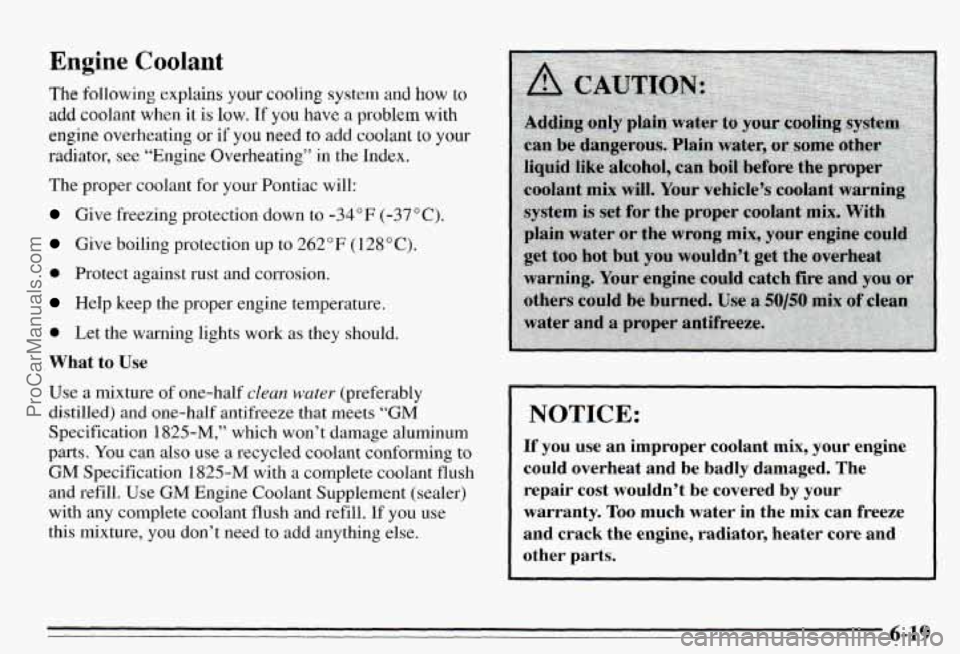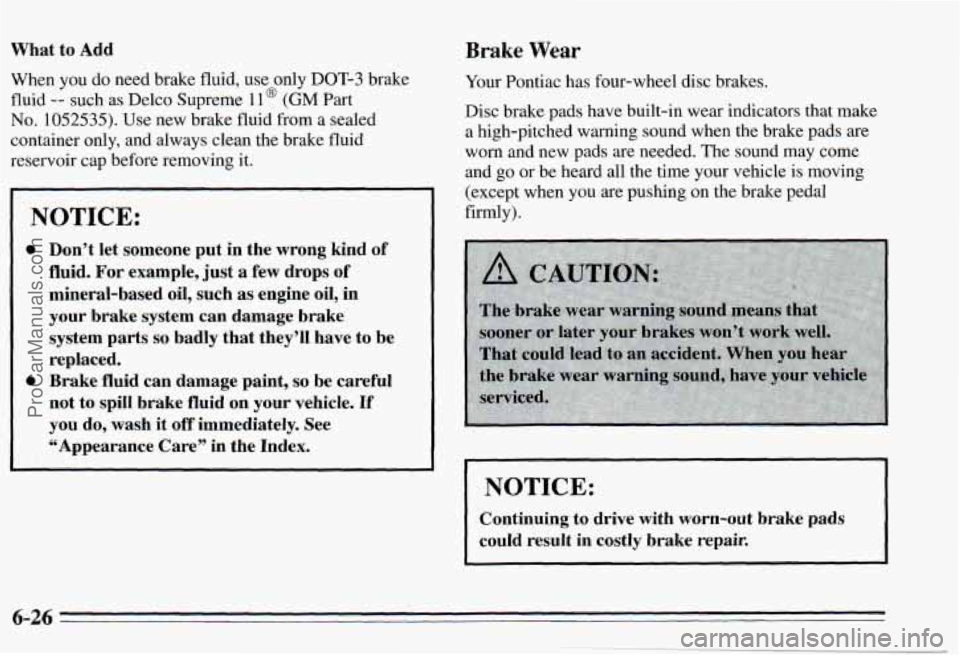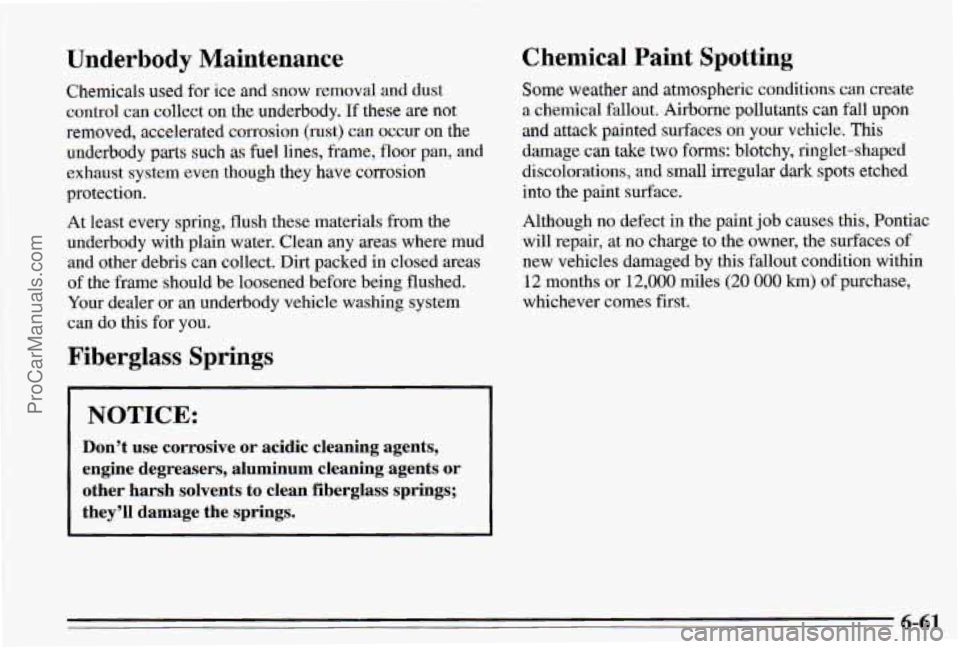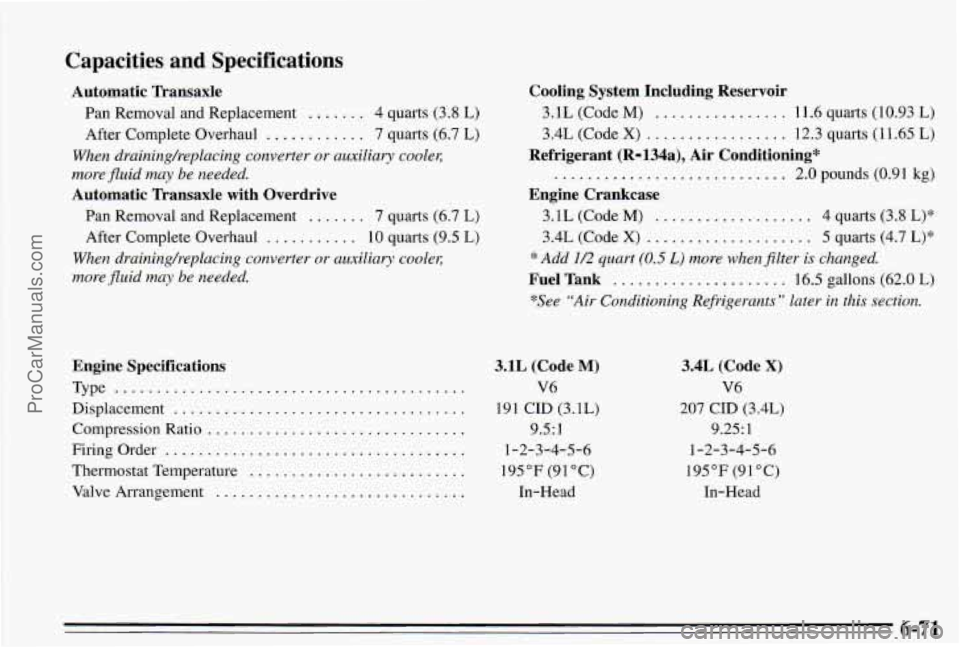Page 232 of 354

Engine Coolant
The following explains your cooling system and how to
add coolant when it is low. If you have a problem with
engine overheating
or if you need to add coolant to your
radiator, see “Engine Overheating” in the Index.
The proper coolant for your Pontiac will:
Give freezing protection down to -34°F (-37°C).
Give boiling protection up to 262°F (128 “C).
0 Protect against rust and corrosion.
Help keep the proper engine temperature.
0 Let the warning lights work as they should.
What to Use
Use a mixture of one-half
clean water (preferably
distilled) and one-half antifreeze that meets “GM Specification 1825-M,” which won’t damage aluminum
parts. You can also use a recycled coolant conforming to
GM Specification 1825-M with
a complete coolant flush
and refill. Use GM Engine Coolant Supplement (sealer)
with any complete coolant flush and refill.
If you use
this mixture, you don’t need to add anything else.
I NOTICE:
If you use an improper coolant mix, your engine
could overheat and be badly damaged. The
repair cost wouldn’t be covered by your
warranty.
Too much water in the mix can freeze
and crack the engine, radiator, heater core and
other parts.
6-19 ProCarManuals.com
Page 233 of 354
Adding Coolant
To Check Coolant
When your engine is cold, the coolant level should be at
the
COLD mark or a little higher. When your engine is
warm, the level should be up to the HOT mark or a little
higher.
If this light comes on, it
means you’re low on engine
coolant.
To Add Coolant
If you need more coolant, add the proper mix at the
coolant recovery tank.
6-20
ProCarManuals.com
Page 235 of 354
Radiator Pressure Cap
NOTICE:
Your radiator cap is a 15 psi (105 kPa)
pressure-type cap and must be tightly installed
to prevent coolant loss and possible engine
damage from overheating. Be sure the arrows
on
the cap line up with the overflow tube on the
radiator filler neck.
When you replace your radiator pressure cap, an A@
cap is recommended.
Thermostat
Engine coolant temperature is controlled by a thermostat
in the engine coolant system. The thermostat stops the
flow
of coolant through the radiator until the coolant
reaches a preset temperature.
When you replace your thermostat, an
AC@ thermostat
is recommended.
Power Steering Fluid
3.1L L82 (Code M) Engine 3.4L LQl (Code X) Engine
How To Check Power Steering Fluid
When the engine compartment is cool, unscrew the cap
and wipe the dipstick with a clean rag. Replace the cap
and completely tighten it. Then remove the cap again
and look at the fluid level on the dipstick.
6-22
ProCarManuals.com
Page 239 of 354

What to Add Brake Wear
When you do need brake fluid, use only DOT-3 brake
fluid
-- such as Delco Supreme 11 @ (GM Part
No. 1052535). Use new brake fluid from a sealed
container only, and always clean the brake fluid
reservoir cap before removing it.
NOTICE:
@ Don’t let someone put in the wrong kind of
fluid. For example, just a few drops of
mineral-based oil, such as engine oil, in
your brake system can damage brake
system parts
so badly that they’ll have to be
replaced.
0 Brake fluid can damage paint, so be careful
not to spill brake fluid on your vehicle.
If
you do, wash it off immediately. See
“Appearance Care” in the Index. Your
Pontiac has four-wheel disc brakes.
Disc brake pads have built-in wear indicators that make a high-pitched warning sound when the brake pads are
worn and new pads are needed. The sound may come
and
go or be heard all the time your vehicle is moving
(except when you are pushing on
the brake pedal
firmly).
NOTICE:
Continuing to drive with worn-out brake pads
could result in costly brake repair.
6-26
ProCarManuals.com
Page 274 of 354

Underbody Maintenance Chemical Paint Spotting
Chemicals used for ice and snow removal and dust Some weather and atmospheric conditions CZUI create
control can collect
on the underbody. If these are not a chemical fallout, Airborne pollutants can fall upon
removed, accelerated corrosion (rust) can occur on the and
attack painted surfaces on your vehicle. This
underbody parts such as %el lines, frame, floor pan, and damage can take two forms: blotchy, ringlet-shaped
exhaust system even though
they have corrosion discolorations,
and small irregular dark spots etched
protection. into the
paint surface.
At least every spring, flush these materials from the Although no defect in the paint job causes this, Pontiac
underbody with plain water. Clean any areas where mud will repair, at
no charge to the owner, the surfaces of
and other debris can collect.
Dirt packed in closed areas new vehicles damaged by this fallout condition within
of the frame should be loosened before being flushed.
12 months or 12,000 miles (20 000 km) of purchase,
Your dealer or an underbody vehicle
washing system whichever comes first.
can
do this for you.
Fiberglass Springs
1 NOTICE: I
Don’t use corrosive or acidic cleaning agents,
engine degreasers, aluminum cleaning agents or other harsh solvents to clean fiberglass springs;
they’ll damage the springs.
6-61
ProCarManuals.com
Page 276 of 354

Vehicle Identification Number (VIN)
UXSMJ72675 Ictn)
4-
-- ~
1995
PLANT MODEL YEAR
ASSEMBLY
This is the legal identifier for your Pontiac. It appears on
a plate
in the front corner of the instrument panel, on the
driver’s side. You can see it
if you look through the
windshield from outside your vehicle. The
VIN also
appears on the Vehicle Certification and Service Parts
labels and the certificates of title and registration.
Engine Identification
The eighth character in your VIN is the engine code.
This code will help you identify your engine,
specifications, and replacement parts.
Service Parts Identification Label
You’ll find this label on your spare tire cover. It’s very
helphl if you ever need to order parts. On this label is:
yoLlrvIN,
the model designation,
0 paint information, and
a list of all production options and special equipment.
Be sure that this label is not removed from the vehicle.
Add-on Electrical Equipment
I NOTICE:
Don’t add anything electrical to your Pontiac
unless you check with your dealer first. Some
electrical equipment
can damage your vehicle and
the damage wouldn’t be covered by your warranty. Some add-on electrical equipment
can keep other
components
from working as they should.
Your vehicle has an air bag system. Before attempting to
add anything electrical to your Pontiac, see “Servicing
Your Air Bag-Equipped Pontiac” in the Index.
6-63
ProCarManuals.com
Page 277 of 354
Fuses and Circuit Breakers
The wiring circuits in your vehicle are protected from
short circuits by a combination of fuses, circuit breakers,
and fusible thermal links
in the wiring itself. This
greatly reduces the chance of fires caused by electrical
problems.
Some fuses are in a fuse
block on the passenger side
of the instrument panel.
Pull off the cover labeled
FUSES to expose the fuses.
Instrument Panel Fuse Block
Additional fuses are in the underhood electrical centers
on the right and left sides of the engine compartment.
Look at the silver-colored band inside the fuse.
If the
band is broken or melted, replace the
fuse. Be sure you
replace a bad fuse with a new one of the identical size
and rating.
Circuit Description
Breaker
C Power Windows
D Power Seats
6-64
ProCarManuals.com
Page 284 of 354

Capacities and Specifications
Automatic Transaxle
Pan Removal and Replacement ....... 4 quarts (3.8 L)
After Complete Overhaul
............ 7 quarts (6.7 L)
When drainingheplacing converter or auxiliary cooleq
more fluid may be needed.
Automatic Tkansaxle with Overdrive
Pan Removal and Replacement ....... 7 quarts (6.7 L)
After Complete Overhaul
........... 10 quarts (9.5 L)
When drainingheplacing converter or auxiliary cooler,
more fluid may be needed.
Engine Specifications
Displacement ...................................
Compression Ratio ...............................
Thermostat Temperature ..........................
Type ..........................................
Firingorder ....................................
ValveArrangement ..............................
Cooling System Including Reservoir
3.1L (Code M) ................ 11.6 quarts (10.93 L)
3.4L (Code
X) ................. 12.3 quarts (1 1.65 L)
............................ 2.0 pounds (0.91 kg)
3.1L (Code M) ................... 4 quarts (3.8 L)*
3.4L (Code
X) .................... 5 quarts (4.7 L)*
*Add 1/2 quurt (0.5 L) more when filter is changed.
Fuel Tank ..................... 16.5 gallons (62.0 L)
*See "Air Conditioning Refrigerants '' later in this section.
Refrigerant (R-l34a), Air Conditioning"
Engine Crankcase
3.1L (Code
M)
V6
191 CID (3.1L) 9.5:
1
1-2-3-4-5-6
195°F (91 "C)
In-Head
3.4L (Code X)
V6
207 CID (3.4L) 9.25:
1
1-2-3-4-5-6
195°F (91°C)
In-Head
6-71 ProCarManuals.com